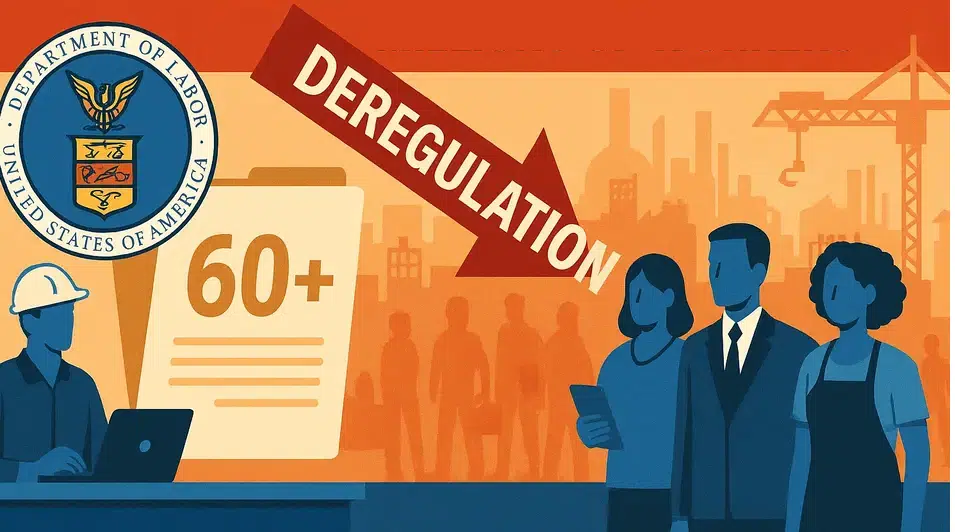The U.S. Department of Labor has unveiled a sweeping package of more than sixty deregulation proposals that would roll back or rewrite workplace rules touching everything from overtime eligibility and independent-contractor status to safety inspections and union elections. Supporters frame the plan as a long-overdue modernization that will cut red tape and spur hiring. Labor advocates, unions, and many Democratic lawmakers call it an unprecedented assault on worker protections that could lower wages, weaken bargaining power, and increase on‑the‑job risks for millions.
What’s in the Package?
According to senior officials, the deregulation slate clusters into four broad buckets:
• Wage and Hour Changes: Revisions to the Fair Labor Standards Act (FLSA) regulations would raise the salary threshold for overtime more slowly than previously planned—or scrap automatic inflation adjustments altogether. Several industry-specific exemptions (hospitality, agriculture, retail commission sales) would be expanded, effectively shrinking the pool of hourly workers entitled to time-and-a-half pay.
• Worker Classification: A new rule would make it easier for companies to classify workers as independent contractors rather than employees. The test would tilt toward “entrepreneurial opportunity” and away from the current multi-factor “economic realities” analysis, dramatically reducing access to minimum wage, overtime, unemployment insurance, and employer-sponsored benefits for gig-economy and app-based workers.
• Occupational Safety and Health: The Occupational Safety and Health Administration (OSHA) would streamline or eliminate dozens of reporting requirements. Employers with strong “safety management systems” could self-certify compliance in lieu of some inspections, and penalties for certain non-serious violations would be capped or waived altogether for first-time offenders.
• Labor-Management and Benefits Rules: The National Labor Relations Board (NLRB) would tighten timelines for union elections and narrow the definition of “joint employer,” making it harder for franchise and contract workers to organize. The Employee Benefits Security Administration (EBSA) would ease fiduciary obligations on retirement-plan advisors, reviving controversy over broker conflicts of interest.
How Did We Get Here?
The proposals follow a 2024 executive order directing agencies to review and “rationalize” all regulations issued since 2010 that impose more than $100 million in annual costs. Business groups, including national chambers of commerce and industry coalitions in logistics, retail, and construction, had lobbied aggressively for relief, arguing that layers of federal, state, and local rules stifle productivity and deter small businesses from hiring.
At the same time, the tight labor market of 2021–2023 forced employers to raise wages voluntarily. Proponents say this proves many protections are redundant in a world where “market forces do the job,” while critics counter that the very existence of labor standards helped create the conditions for those wage gains—and that a cooling economy makes rollbacks especially dangerous.
Who’s Affected and How Many?
The Labor Department estimates that more than 30 million workers could see a direct change in how they’re classified, paid, or protected if the rules take effect as drafted. Key groups include:
• Low- to Mid-Wage Salary Workers: Assistant managers in retail, frontline supervisors in food service, and administrative coordinators in healthcare who currently hover near the overtime salary cutoff could lose guaranteed overtime pay if thresholds stall.
• Gig and Contract Workers: Drivers, delivery couriers, freelance coders, and content creators operating through platforms may find it harder to claim employee status, curtailing access to unemployment insurance, workers’ compensation, and employer-sponsored health plans.
Hiring Gig or Contract Talent? Post Jobs for Free
With policy shifts redefining worker classifications, gig professionals—from drivers and delivery couriers to freelance coders and content creators—are seeking stable contracts and trusted platforms. If you’re hiring for short-term projects or flexible roles, WhatJobs can help you connect with reliable, motivated workers. Post your job openings for free today.
Post Your Contract Job Now →• Small Manufacturers and Construction Crews: Fewer OSHA inspections may speed projects but also raise the stakes for accidents. Workers in hazardous trades worry that “self-certification” will invite corner-cutting—especially among subcontractors.
• Franchise and Temp Workers: Narrower joint-employer rules mean national brands can offload liability to local franchisees or staffing agencies. Organizing efforts aimed at corporate headquarters could be stymied, fragmenting bargaining units.
Business Case vs. Worker Risk
Business advocates argue the changes will:
• Lower compliance costs and free cash flow for investment and hiring. • Provide legal clarity on contractor status, reducing litigation. • Encourage innovation in scheduling and pay structures now constrained by inflexible rules.
Labor advocates respond that:
• “Clarity” is a euphemism for denying workers basic protections. • Lower penalties and fewer inspections remove vital deterrents for unsafe workplaces. • Weaker overtime and classification rules will push wage theft and unpaid hours back into the shadows.
Economists are split. Deregulation could raise productivity but also compress wages at the bottom, potentially dampening consumption. In cyclical downturns, looser rules may accelerate layoffs since severance and compliance costs are smaller.
Legal Path and Timeline
The deregulation package will proceed through the Administrative Procedure Act (APA) rulemaking process: proposal publication, a public comment period (likely 60–90 days), review of comments, and a final rule. Expect:
• Immediate Lawsuits: Unions and worker-advocacy groups are poised to sue, arguing the changes are arbitrary, capricious, or conflict with statutory language. Courts could issue injunctions, delaying enforcement for months.
• Congressional Review Act Threats: If finalized late in the year, a future Congress could overturn the rules with a simple majority vote and presidential signature.
• State Countermeasures: Blue states may pass tougher wage and classification standards, creating a patchwork that undermines the “clarity” business seeks. Multistate employers could face conflicting obligations.
Safety and Health: Streamlining or Backsliding?
OSHA’s proposed self-certification path is one of the most controversial elements. Companies with robust Environmental, Health, and Safety (EHS) programs could bypass certain inspections, but critics question whether voluntary systems can substitute for independent eyes on the ground. Injury reporting thresholds may rise, potentially undercounting accidents and illnesses. Supporters counter that OSHA’s limited resources are better spent on “bad actors,” not firms with clean records.
Meanwhile, industry-specific standards—like those for silica exposure in construction or process safety management in chemical plants—could be re-opened for “flexibility,” raising alarms among unions and safety engineers who say these rules were hard-won after deadly incidents.
Overtime and Wages: The Threshold Battle
For decades, the overtime salary threshold has been a tug-of-war. The Labor Department’s last major increase set it near $55,000 with automatic adjustments. The new proposal would freeze or slow those increases, and expand exemptions for “executive, administrative, and professional” roles even if duties remain largely manual or clerical. Employers gain scheduling freedom; workers risk longer hours with no extra pay.
In service sectors, employers may game titles—promoting employees to “assistant manager” without meaningful authority to sidestep overtime. Worker advocates want a duties test with teeth and a threshold tied to median wages, not politics.
Independent Contractors: Redefining “Who Works for Whom”
Under the proposed test, control over work schedules and the opportunity for profit or loss weigh heavily. A graphic designer with multiple clients and her own marketing may qualify as a contractor, but so might a delivery driver bound by an app’s algorithm if the company argues he can “choose his hours.” Critics say this flips the logic of labor law, letting form trump substance.
The change also reverberates in tax policy: more 1099 workers means less payroll tax collection for Social Security and Medicare unless Congress intervenes. States may respond by tightening their own tests (like California’s ABC test), deepening the compliance maze.
Union Elections and Joint Employers: Narrowing the Lane
The NLRB’s proposal accelerates election timelines but adds procedural hurdles that unions say favor employers—requiring more detailed voter lists earlier but allowing employers to challenge eligibility later, potentially invalidating ballots. Meanwhile, a narrower joint-employer rule means big franchisors can avoid bargaining obligations, forcing unions to organize thousands of tiny units instead of one nationwide entity.
For workers in warehouses, hotels, and restaurants, where subcontracting is rampant, the combined effect could thwart collective action and weaken leverage in wage negotiations.
Retirement and Health Benefits: Who Bears Fiduciary Risk?
Easing fiduciary standards for retirement-plan advisors revives a long debate over conflicts of interest. Employers may find it cheaper to offer plans, but workers could be steered into higher-fee products. On health benefits, less stringent reporting on self-funded plans could reduce transparency about claim denials and cost-sharing.
Macro Impact: Prices, Productivity, and Inequality
If businesses save billions in compliance costs, some of that could flow to investment, hiring, or consumer price cuts. But if wage protections weaken, consumer demand might suffer, especially among low-income households who spend most of their income locally. The net effect hinges on how employers deploy their “savings” and whether states fill regulatory gaps.
Productivity could rise where cumbersome paperwork is replaced by digital compliance tools. Yet safety lapses and litigation costs could offset those gains if corners are cut too aggressively. Economists warn of a “race to the bottom” in states that mirror federal rollbacks without strong enforcement capacity.
What Workers and Employers Should Do Now
For Workers: • Track your classification, hours, and duties. Keep personal records in case of disputes. • Join or form worker committees to share information about rights and changes. • Explore state-level protections; many states already exceed federal standards.
For Employers: • Conduct compliance audits—misclassification lawsuits are expensive. • Invest in HR tech that automates recordkeeping and minimizes errors. • Consider reputational risk: transparent, fair policies can attract talent even without mandated rules.
The Political Wild Card
An election year looms. Candidates are already framing the package as either a “job-creation catalyst” or a “war on workers.” Depending on November’s outcome, some or all of these rules could be halted, rewritten, or overridden by statute. Business groups may push for permanence through legislation; labor groups will push Congress to codify stronger standards.
Outlook: Negotiation or Litigation?
Most observers expect a lengthy slog of court battles, state pushback, and incremental rewrites. Some proposals may be softened during the comment period, especially those drawing bipartisan concern (like cutting safety inspections in high-hazard industries). Others—like contractor reclassification—will likely be litigated up to the Supreme Court.
In the meantime, the mere announcement is reshaping behavior: employers are lawyering up and redesigning job descriptions; unions are accelerating campaigns; states are drafting contingency bills. The next 12 to 24 months will determine whether this deregulation wave becomes a permanent reset of U.S. labor policy or a short-lived detour.
FAQ
How many rules are being changed?
More than sixty individual measures spanning wage-and-hour law, safety standards, union rules, and benefits oversight.
When do these changes take effect?
Not immediately. Each proposal enters a public comment period and must be finalized; lawsuits could delay implementation for months or years.
Will my overtime pay disappear?
It depends on your salary, duties, and industry. If the salary threshold stops rising and exemptions expand, you might lose eligibility unless your state sets higher standards.
I’m a gig worker—what changes for me?
You may find it harder to claim employee status for wages, unemployment insurance, or benefits. Check your state’s classification rules; some states offer stronger protections.
Bottom Line:
The Labor Department’s deregulatory blitz could redraw the map of U.S. workplace protections. Whether it unleashes growth or sparks a surge in wage theft, injuries, and inequality will depend on final rule language, court rulings, state responses, and how employers choose to wield their new freedom.




